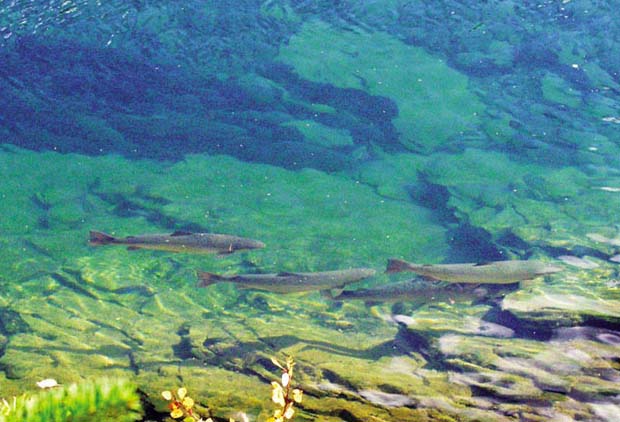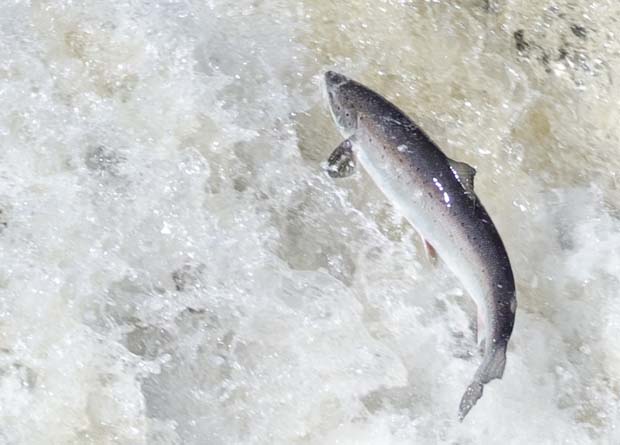Fisheries and Oceans Canada (Department of Fisheries and Oceans) is diluting its Fisheries Act to further fish farming and does so by proposing regulations that substantially alter the way the Canada Fisheries Act is applied to aquaculture activities
BILL ERNST / Published October 15, 2014
Fisheries and Oceans Canada is proposing regulations that would substantially alter the way the Canada Fisheries Act is applied to aquaculture activities
[dropcap]T[/dropcap]he proposed regulations functionally exempt aquaculture operations from the general provisions (Section 36) of the Fisheries Act, which prohibits the deposit of deleterious substances into water frequented by fish. They will allow the deposit of pesticides and drugs into the aquatic environment as long as they are authorized for use under the Pest Control Products Act or the Food and Drugs Act.
The rationale put forward to justify these regulations is that there is currently overlap of regulatory requirements both federally and provincially and among various federal departments, which is “cumbersome” for the aquaculture industry, and creates economic disincentives that are barriers to the sustainable management of aquaculture.
Not many would argue against regulatory streamlining where there is no real purpose served by overlapping legislation, especially if it is an unreasonable economic burden or it unduly stifles business initiatives.
In my opinion, however, that is not the case in this situation and the proposed regulations can only further reduce environmental protection from aquaculture activities.
The issue of regulatory uncertainty placing an unreasonable burden on the aquaculture industry and acting as an investment disincentive is the same issue that all other industries in this country deal with. Navigating regulatory requirements is a cost of doing business and all durable industries have managed to do it, while affording the environmental protection provided by the current Fisheries Act, which has been in force for over 100 years.
The basic premise of the proposed changes to the Fisheries Act is that registration under legislation managed by Health Canada is adequate to ensure aquatic environmental protection.
This premise is not supportable for a number of reasons. Although registration under the Pest Control Products Act involves an aquatic risk determination, that risk assessment is done by an agency that does not have a singular environmental protection mandate.
It is also done in a less than totally transparent manner based on a pre-use data set provided largely by the chemical manufacturer. In addition, there is negligible environmental assessment conducted under the Food and Drugs Act and the environmental effects of drugs on the aquatic environment are therefore largely unknown prior to use.
There are no subsequent environmental effects monitoring activities undertaken by Health Canada after pesticides or drugs are put into operational use, as has historically been done by Environment Canada, the agency responsible for Section 36 of the Fisheries Act.
Conveniently, such programs have recently been eliminated in Environment Canada and Fisheries and Oceans Canada. The proposed regulations also make no provision for collection of environmental impact data for pesticides or drugs in the aquatic environment.
Section 36 of the Fisheries Act has always served as a “backstop” against the use of high-risk chemicals in the aquatic environment. It has never been used in a reckless or frivolous manner, and I would challenge the aquaculture industry as well as the authors of this legislation to show where that has been the case.
This section has, however, been recently used against Kelly Cove Salmon Ltd. in New Brunswick, which deliberately used a prohibited pesticide, known to have a very high environmental risk, even after warnings to cease.
In my opinion, the real reason for these regulations is to allow this industry access to a wider array of more powerful pesticides and drugs, which would be challenged by the current Fisheries Act provisions based on an understanding of their high environmental risk.
The industry in particular wants access to a class of pesticides known as pyrethroids, which have been proposed for registration for use against sea lice under the Pest Control Products Act.
Recent research by Environment Canada and Fisheries and Oceans Canada has demonstrated lethal effects of pyrethroids to marine organisms hundreds of metres from the sea cages in which they are used and subsequently released to the environment. They have also been shown to cause lobster mortality near salmon net pens.
While these chemicals are also used in agriculture, their aquatic toxicity has been judged to be so severe as to require users to protect aquatic ecosystems by buffer zones of up to 100 metres. How will those users feel about being held to comply with such restrictions in the future if the aquaculture industry is allowed to deposit those same pesticides directly into the marine environment?
It would seem at this point that the aquaculture industry has convinced the federal government that they require special treatment under the Fisheries Act. This might be due to the perception that this industry provides a viable alternative to failing wild fisheries and therefore any obstacles to expansion, including major environmental protection legislation, should be removed.
Paradoxically, it seems that removing that legislative obstacle will increase the stress placed on the few wild fisheries that are still productive. If passed, this regulation regresses and confounds application of the most important aquatic protection legislation in this country; another step this country has taken in reducing environmental security in favour of economic advancement.
About the author
Bill Ernst is a recently retired biologist from Environment Canada who has conducted research on the environmental effects of aquaculture chemicals. He lives in Middle Sackville.
[information]
Atlantic Salmon Federation website . . .
[/information]





